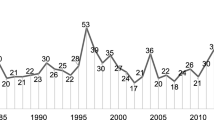Summary
There is a strong rationale for integrating pharmacoeconomics into research and development (R&D) project selection and termination decisions. The average cost for the typical new drug introduction now exceeds $US300 million. Furthermore, a growing proportion of phase III projects are terminated because of economic factors relative to efficacy and safety concerns. While the use of pharmacoeconomic studies by payers is still evolving, the pressures on firms to show that new products are cost effective will only intensify in future periods. Accordingly, it is important for firms to begin analysing the cost effectiveness of new drug candidates early in the R&D process.
The cost effectiveness of a new therapy can be simulated prior to clinical testing using different assumptions about the efficacy, tolerability, pricing and formulation of the new therapy. These models can be refined and updated as data become available from clinical testing and other sources. A key objective is to make uncompetitive projects fail sooner while channelling development resources to projects with high expected returns. Cost-effectiveness analysis should be an integral component of the firms’s strategic action plan and its return on investment analyses.
Similar content being viewed by others
References
Kunze ZM, Lumley CE, Walker SR. Socioeconomic evaluation of medicines: a survey of the international pharmaceutical industry. Carshalton: Centre for Medicines Research, 1993
DiMasi J, Hansen R, Grabowski H, et al. The cost of innovation in the pharmaceutical industry. J Health Econ 1991; 10: 107–42
Pharmaceutical Manufacturers Association, PMA Annual Survey Report: Trends in U.S. Pharmaceutical Sales and R&D, Washington, DC, 1993
DiMasi J, Seibring MA, Lasagna L. New drug development in the United States from 1963 to 1992. Clin Pharmacol Ther 1994; 55(6): 609–22
U.S. Congress Office of Technology Assessment. Pharmaceutical R&D: costs, risks and rewards. Washington, DC: Government Printing Office, 1993
The Boston Consulting Group. The changing environment for U.S. Pharmaceuticals. New York: Apr 1993
Grabowski H, Vernon J. Returns to R&D on new drug introductions in the 1980s. J Health Econ 1994; 13: 383–406
Grabowski H, Vernon J. A new look at the returns and risks to pharmaceutical R&D. Manage Sci 1990; 36(7): 167–85
Shaw HK. Catalysts for change: the impact of generic drugs on the pharmaceutical industry. Burlington (MA): Spectrum, Report 38, Decision Resources, Dec 28, 1992
Grabowski H, Vernon J. Longer patents for increased generic competition in the US: the Waxman-Hatch Act after one decade. Pharmacoeconomics 1996; 10 Suppl. 2: 110–23
Sloan F, Grabowski H, editors. The role of cost-effectiveness analysis in public and private sector decisions. Soc Sci Med 1997. In press
Davies L, Coyle D, Drummond M, et al. Current status of economic appraisal of health technology in the European Community: report of the network. Soc Sci Med 1994; 38(12): 1601–7
Drummond M, Rutten F, Brenna A, et. al. Economic evaluation of pharmaceuticals: a European perspective. Pharmacoeconomics 1993; 4(3): 173–86
Raiffa H. Decision analysis: introductory lectures on choices under uncertainty. New York: McGraw Hill, 1968
Mansfield E. Statistics for business and economics. New York: W. W. Norton, 1987: 625–95
Clemens K, Garrison LP, Jones A. Strategic use of pharmacoeconomic research in early drug development and global pricing. Pharmacoeconomics 1993; 4(5): 315–22
Schulpher MS, Drummond MF, Buxton MJ. The iterative use of economic evaluation as part of the process of health technology assessment. J Health Serv Res Policy 1997; 2(1): 26–30
Drummond MF, Stoddart GL, Torrance GW. Methods for the economic evaluation of health care programmes. New York: Oxford University Press, 1987
Smith TJ, Hilner BE, Neighbors DM, et al. Economic evaluation of a randomized clinical trial comparing vinorelbine, vinorelbine plus cisplatin, and vindesine plus cisplatin for non—small-cell lung cancer. J Clin Oncol 1995; 13(9): 2166–73
Sharples LD, Briggs A, Caine N. A model for analyzing the cost of main clinical events after cardiac transplantation. Transplantation 1996; 6(5): 615–21
Spilker B. Multinational pharmaceutical companies: principles and practices. 2nd ed. New York: Raven Press, 1994: 567–83
Recombinant Capital. Index of life science agreements. San Francisco, CA: 1996
DiMasi JA. Success rates for new drugs entering clinical testing in the United States. Clin Pharmacol Ther 1995; 58(1): 1–14
Grabowski H. Health reform and pharmaceutical innovation. Washington, DC: The AEI Press, 1994: 17–8
Moore SD, Revzin P. Success of Ciba-Sandoz merger will be tested in the lab. Wall Street Journal, 30 July 1996: B4
Pharmaceutical industry overview report: a fistful of dollars. New York: Bear Sterns & Co., Inc., 26 Aug 1996: 23
Drummond MF, Davies L. Economic analysis alongside clinical trials: revisiting the methodological issues. Int J Technol Assess Health Care 1991; 7: 561–73
Rittenhouse BE, O’Brien BJ. Threats to the validity of pharmacoeconomic analyses based on clinical trial data. In: Spilker B, editor. Quality of life and pharmacoeconomics in clinical trials. 2nd ed. Philadelphia: Lippincott-Raven Publishers, 1996: 1215–23
Lyles A, Luce BR, Rentz AM. Managed care pharmacy, socioeconomic assessments and drug adoption decisions. Soc Sci Med 1997. In press
Sloan F, editor. Valuing health care: costs, benefits and effectiveness of pharmaceuticals and other medical technologies. Cambridge: Cambridge University Press, 1995
Spilker B. Quality of life and pharmacoeconomics in clinical trials. 2nd ed. Philadelphia: Raven Publishers, Part XI: 1077–228
Author information
Authors and Affiliations
Corresponding author
Rights and permissions
About this article
Cite this article
Grabowski, H. The Effect of Pharmacoeconomics on Company Research and Development Decisions. PharmacoEconomics 11, 389–397 (1997). https://doi.org/10.2165/00019053-199711050-00002
Published:
Issue Date:
DOI: https://doi.org/10.2165/00019053-199711050-00002




